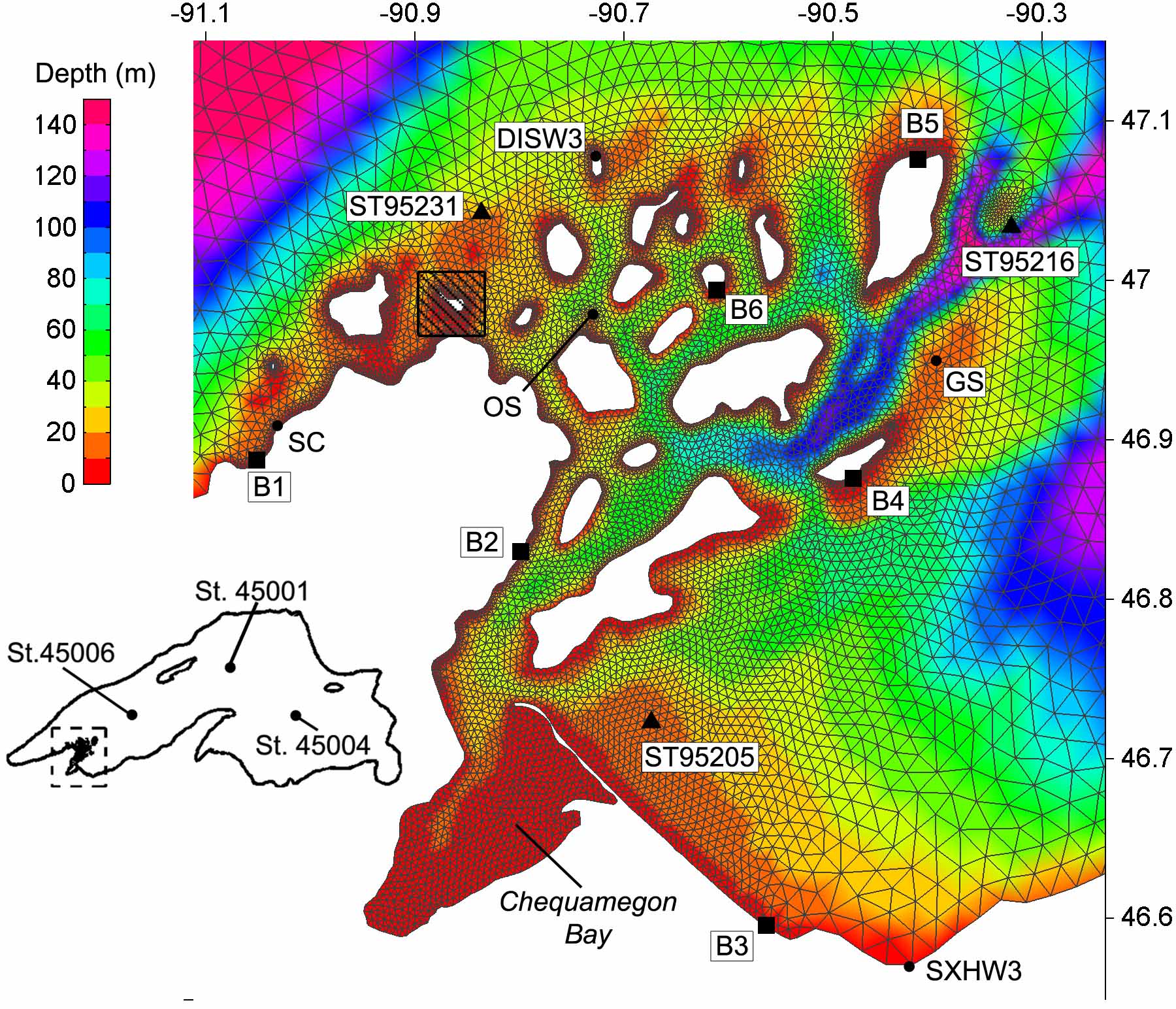


Apostle Islands in Lake Superior Real-time wave buoy and nowcast/forecast modeling 15 feet extreme wave
Media
- Apostle Islands Wave Buoys, Great Lakes Cruising Club, July 2021.
- City
by City: Duluth, Bayfield, Apostle Islands. CBS3,
Duluth, June 2021.
- Real-time
wave information expands for paddlers and boaters in
the Apostle Islands, Friends of the Apostle Islands
National Lakeshore, 2021
- Real-time
wave data now available for Apostle Islands, Duluth
News Tribune, June 2021.
- New
website offers real-time Apostle Islands wave
conditions, Duluth Star Tribune, June 2021.
- Real-time wave information expands for paddlers and boaters in the Apostle Islands, UW Sea Grant, June 2021
- Kayaking
the Apostles, Midwestweekends, June 2020
- Wisconsin
Sea Grant engineer retires, Superior Telegram, Feb.
2019.
- Increasing Safety at Sea Caves, UW-Sea Grant, August 2018.
- A
Career Solving Wicked, Sticky and Humongous
Coastal Engineering Problems, UW-Sea Grant, Oct.
2018.
- Taking on the Waves - All Ways Forward, UW-Madison
- Meet
RTWOS, Friends of Apostle Islands National Lakeshore,
Dec. 2016.
- Coastal Tourism: Sea Caves Watch Project Saves Lives, Changes Hands, NOAA-Sea Grant, June 2016.
- Passing
the Torch: National Park Service Takes Over Sea Caves
Watch Project, Aquatic Sciences Chronicle, Vol 4,
2015.
- Wave
observation system makes Apostle Islands sea caves
safer for kayakers, Duluth News Tribune, Sept. 2015
- Apostle Islands sea caves safer for kayakers, thanks to UW, Milwaukee-Wisconsin Journal Sentinel, August 2015
- Sea
Caves Watch promotes kayaker safety in northern
Wisconsin, UW-COE, August 2015
- Successful Sea Caves Watch Project Saves Lives, Changes Hands, UW-Sea Grant, Aug. 2015
- Apostle
Islands National Lakeshore Kayakers Gain Better
Real-Time Information On Water Conditions, National
Parks Traveler, Aug. 2013.
- On
Campus: Apostle Islands kayakers get real-time view of
caves from shore, Wisconsin State Journal, Aug. 2013.
- Another
Safety Measure in Place for Apostle Island Sea Cave
Kayakers, UW-Sea Grtant Aug. 2013.
- Remote wave sensor warns kayakers, others of dangerous water conditions, Great Lakes Echo, August 2012.
- Sea
Caves Watch sensor deployment 2012 | Flickr, UW-Sea
Grant, 2012.
- Real-Time Wave Information Available for Kayakers in the Apostle Islands, UW-Sea Grant, July 2012.
- Real-Time Wave Information for Kayakers in the Apostle Islands, UW-Sea Grant, Aug. 2011.
- Sea Caves Watch Council Tour, Aug 2011, Apostle Islands | Flickr, UW-Sea Grant, 2011
- Sea
Cave Wave Report, Town of Bell, Cornucopia, 2011
- Real-time wave information system at the Apostle Islands Mainland Sea Caves, pp6-7, Wisconsin Great Lakes Chronicle, 2010
- Wave sensor may improve kayak safety, NPS, 2009.
- Increasing Safety at Sea Caves, Wisconsin Sea Grant youtube, July 2009.
- Increasing
Safety at Sea Caves, Aquatic Sciences Chronicle,
Summer 2009.
Publications
- Anderson, J.D. and Wu, C.H., Development and Application of a real-time water environment cyber-infrastructure for kayaker safety in the Apostle Islands, Lake Superior, Lake Superior. J. of Great Lakes Research, 44(5), 990-1001, doi.org/10.1016/j.jglr.2018.07.006, 2018
- Anderson, J.D., Wu, C.H., and Schwab, D.J., Wave
climatology in the Apostle Islands, Lake Superior, J.
Geophysical Research-Oceans, 120(7), 4869-4890,
2015.
- Young C.C. and Wu, C.H., A σ - coordinate
non-hydrostatic model with embedded Boussinesq-type like
equations for modeling deep-water waves, International
J. for Numerical Methods in Fluids,
63(12),1448-1470, 2010.
- Wu, C.H., Young, C.C., Chen, Q.J., and Lynett, P.J., Efficient non-hydrostatic modeling of nonlinear waves from shallow to deep waters, J. of Waterway, Port, Coastal, and Ocean Engineering - ASCE, 136(2), 104-118, 2010.
- Young, C.C. and Wu, C.H., Non-hydrostatic modeling of nonlinear deep-water wave groups, J. of Engineering Mechanics-ASCE, 136(2), 155-167, 2010.
- Young, C.C. and Wu, C.H., An efficient and accurate non-hydrostatic model with embedded Boussinesq-type like equations for surface wave modeling, International J. for Numerical Methods in Fluids, 60(1), 27-53, 2009.
- Young, C.C., Wu, C.H., Kuo, J.T., and Liu, W.C., A higher-order sigma-coordinate non-hydrostatic model for nonlinear surface waves, Ocean Engineering, 34(10), 1357-1370, 2007.
- Yao, A. and Wu, C.H., Spatial and temporal characteristics of transient extreme waves on depth-varying currents, J. of Engineering Mechanics-ASCE, 132 (9), 1015-1025, 2006.
- Choi, D.Y. and Wu, C.H., A new efficient 3D non-hydrostatic free-surface flow model for simulating water wave motions, Ocean Engineering, 33(5-6), 587-609, 2006.
- Yuan, H.L. and Wu, C.H., Fully non-hydrostatic modeling of surface waves, J. of Engineering Mechanics-ASCE, 132 (4), 447-456, 2006.
- Wanek, J. and Wu, C.H., Automated trinocular stereo imaging system for three-dimensional surface wave measurements, Ocean Engineering, 33(5-6), 723-747, 2006. (see breaking wave evolution here)
- Yao, A. and Wu, C.H., Incipient breaking of unsteady waves on sheared currents, Physics of Fluids, 17, 082104, 2005.
- Yao, A. and Wu, C.H., An automated image-based technique for tracking surface wave profiles, Ocean Engineering, 32(2) 157-173, 2005.
- Yao, A. and Wu, C.H., Energy dissipation of unsteady wave breaking on currents, J. Physical Oceanography, 34, N10, 2288-2304, 2004.
- Wu, C.H., Yao, A., and Chang, K.A., DPIV measurements of unsteady deep-water wave breaking on following currents, "PIV and Modeling Water Wave Phenomena, World Scientific Publication Co., Advances in Coastal and Ocean Engineering - Vol. 9, 2004.
- Wu, C.H., Nepf, H.M., Cowen, E.A., Surface current and vorticity generated by three-dimensional breaking waves, accepted under revision J. Fluid Mech., 2004.
- Wu, C.H. and Nepf, H. M, Breaking wave criteria and energy losses for three-dimensional breaking waves, C10, 3177, 10.1029 2001JC001077, 41-1-18, J. Geophysical Research-Oceans, 2002.
- Nepf, H.M., Wu, C.H., Chan, E.S., A comparison of two- and three-dimensional wave breaking, J. Physical Oceanography, 28, N7, 1496-1510, 1998
- Sea Caves Watch (Real Time Wave Observation System)
- Safety index for kayaks in Sea Caves
- Water Information for a Safe Coast (WISC-Watch)
- INFOS - Apostle Islands for waves and circulations